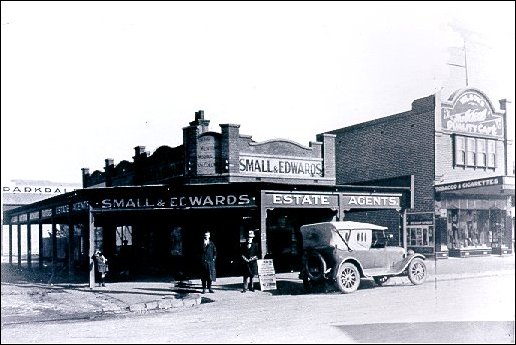Land Sales at Parkdale

Norman Thomas on left with Geoff Connard outside the office of Small & Edwards, Estate Agents, Parkdale, c1930.
The railway station at Parkdale was officially opened in September 1920, and I took charge of my office on 20 December 1920 as Manager of Small & Edwards, Estate Agents.
In March 1921 vacant allotments of land on the beach side of the railway line were sold for prices ranging from £208 to £290 and on the Eastern side up to Point Nepean Road at from £75 to £110. Small houses were sold for £350 and better homes for £550. In July of that year blocks in Point Nepean Road and North Parkers Road brought £132/10/- to £150. In 1922 land in Herbert Street was sold for £260 and five-roomed houses on the beach side at £825 and on the eastern side for £675. March 1923 saw prices slightly higher. Vacant land changed hands for over £300 per block and good homes for £1650. Keith Street sub-division (adjoining the Recreation Reserve which was acquired by the local Council that year.) were sold for £75 to £110. This street was unmade and no water supply was available.
In January 1924 land at the top of Fifth, Sixth, Seventh and Eighth streets was subdivided and prices ranged from £60 to £125. On the beach side in Parkers Road blocks sold for £315. A four roomed villa brought £875. Prices remained steady during the following five years to 1929. Then a world-wide depression set in and there was very little, if any movement at all in the property market until 1935. During that year and 1936 prices were similar to those obtained in 1921-1922 as finance was very difficult to obtain. Well built villas, with all conveniences, were sold for as low as £585 and on very easy terms of purchase. Vacant blocks could be bought for £80 and those near the beach for £100 to £150.
1937 showed an increase of sales at prices very little in advance of those in previous years. Purchases seemed to have more confidence in 1939 and 1940 and sales were more frequent at slightly higher prices but not as high as 1924. 1941 started out with buyers willing and eager to buy and the number of sales doubled those of the previous year. Prices hardened for newly built homes and those in good positions sold up to £1000.
The year 1942 continued in the same strain as did 1943, despite the fact that the Second World War was being waged and the Japanese were advancing in the Pacific Ocean and attacking Darwin by air. The Coral Sea battle was fought and with the help of the Americans we were able to turn the Japanese back. Times were very grim. All able bodied men were called up to defend the country. Many blocks of land were sold to the wives and fiancees of members of the defence forces fighting overseas and those were built on when the war ceased.
1944 brought an upsurge in sales and were fifty percent higher than 1942, but 1945 revealed the biggest jump in the turnover of properties being 100% on the last year. Prices for vacant land were 50% up on 1939. A new subdivision of land on Warren Road towards the Golf links added to the supply of home sites and were eagerly bought. New houses were bringing up the £2,600 to £3,500.
In 1946 there was a big increase in prices and the turnover of properties was still on the increase. The same applied to 1947 and when the men came home from the war, there was upsurge in the building trade. Vacant blocks were eagerly sought and new houses were being erected in every street in the area. 1948 and 1949 showed a return of confidence and prices hardened with demand exceeding the supply. 1950 showed a further improvement but slowed down in the first half of 1951. Buyers were being more discriminating.
I left the district in July 1951 to go to northern New South Wales on a banana plantation with my sons and I am still in that area.
A point of interest is that sales of property through my office from 1920 to 1951 amounted to over one million dollars and other estate agents in the area probably did just as well. During my time in Parkdale I saw no less than eight agents come and go.
Footnotes
- Norman Thomas was born in Mordialloc on August 6, 1899 and died in Sydney February 19, 1981. This article was written in the 1970’s to assist a grand-daughter with a school project.
